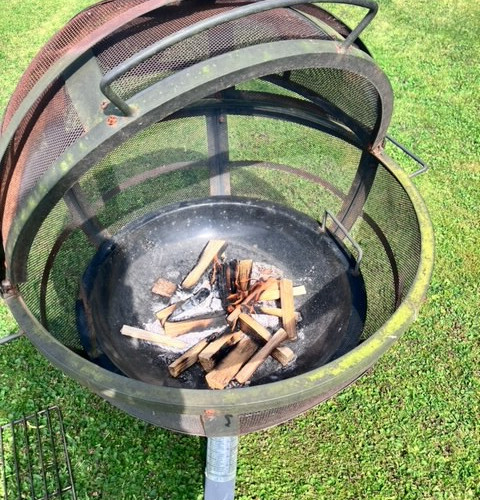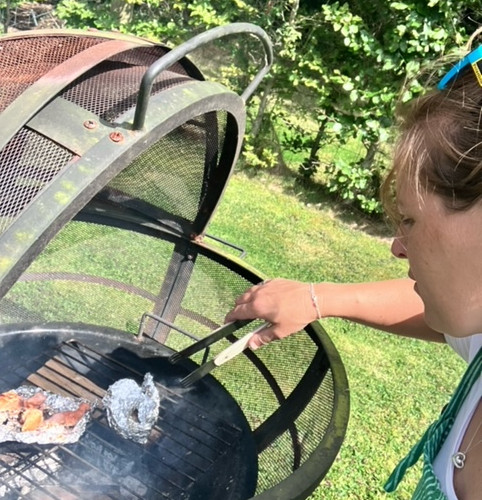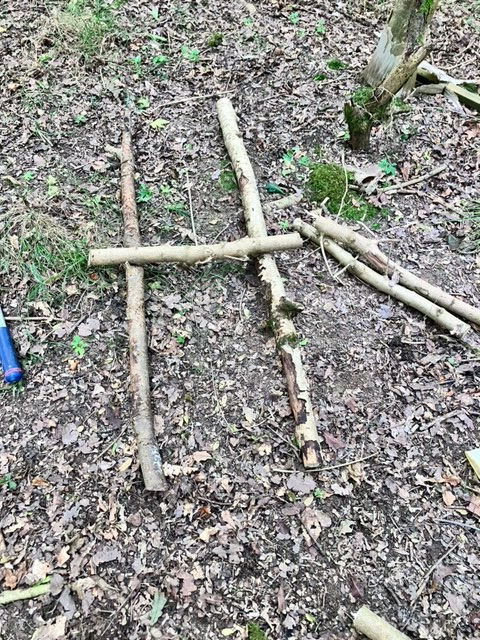2.2- Learning Resources (Unit 2): Demonstrate simple methods of cooking over a campfire with due regard to basic food hygiene and explain how this can be taught to a client group
- Naomi Harvey

- Aug 25, 2024
- 3 min read
To begin with I started lighting the fire pit, allowing it to grow flames and produce a strong heat.
I then placed a grill over the top, to hold the food implements we needed. Start off with washing your hands, within the forest school setting, we supply bottles of water to allow this.
Fire Pit Menu:
Steamed Salmon
Baked Potato
Egg Fried Rice
I chose this menu as I thought it was a good selection of different foods and ways to cook. If we had children that were vegetarians or have allergies, they should hopefully be able to have at least one thing from the menu.
I begin by putting water in a saucepan and placing the rice in the water and placing it on top of a grill.
After stabbing the potato a few times with a fork, I wrap it up in tin foil and place this on the grill. I would use this as a good teaching moment to explain to the children that foil retains heat and it must not be touched without a fire glove and adult supervision.
The salmon comes from the packet and I place it in a boat-like shape of tin foil, this can create a steaming effect for the salmon and does not allow it to burn.
The eggs, I use a plastic bowl and a fork, crack 4 eggs into the bowl and mix with a fork.
I use a wooden spoon, as this will not warm up when being used, to mix the rice, and every now and again I turn the potato over.
After 30 minutes the potato should be soft and the salmon nearly cooked, the rice should also be almost cooked and the water nearly all gone, rather than having to strain the rice, I remove the rice from the heat and kept stirring, this means the rice keeps cooking slowly and the water will be being absorbed.
Once I have taken the rice off, I place the egg in a small saucepan and keep mixing it and frying to make scrambled egg.
This takes about 5 minutes to cook. By this time the rice has cooled slightly, I add the egg, creating egg fried rice.
I cut open the jacket potato with a small knife and fork, and placed it on our outdoor plate, along with the rice and salmon.
I have use of a chopping board to lean upon, however, as I am using tin foil as a bad no food should come into contact with the board, meaning we can use fo all the food. When I remove the saucepan from the fire, I place a metal griddle on the floor to protect the ground from the heat.
After I have finished, I let the fire die down and not add any more fuel.
While this is happening, I have provided a food waste bag to remove any food that could go into the compost, any rubbish, including the foil I place it in a separate bag to remove from the site.
In our Forest school, dirty pans and bowls are removed from the site and cleaned back at the school. Although it is a permanent fire, we must not leave any resources on site and leave the area clean and tidy.
I allow the fire to die down and push the ash around to make sure there are no more burning embers, I cover it with water and mixed it in to allow the ash to cool. I hold the back of my hand over the back of the fire to test for any heat before I leave site.
I would make sure I show the children every step of the cooking process and express the importance of food hygiene, keeping our hands clean and not handling any foods. We would supply all needed utensils and use a fire glove to remove anything from the griddle. As forest school leaders, we must also ensure that no rubbish or left over food is left on site, if we were to leave any food on site, this would encourage animals to attend the site and may cause damage to the site or harm the animal!
I have attached a slideshow below with short captions to explain what I am showing (captions shown on larger pictures)





























Comments